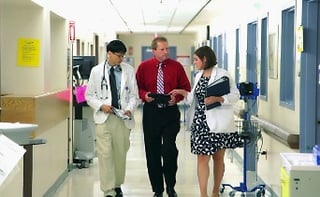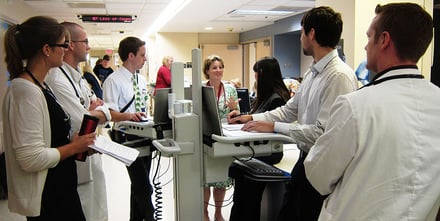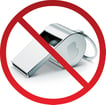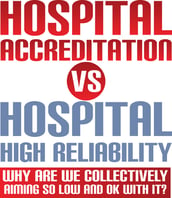
Hospital leadership rounds work because they:
Improve Staff Retention

"Before you can inspire with emotion, you must be swamped with it yourself. Before you can move their tears, your own must flow. To convince them, you must yourself believe." ~ Winston Churchill
Seeing senior staff conducting regular leadership rounds in the hospital contributes to a very positive work environment. This is particularly effective when the leaders look for opportunities to connect with staff and to identify and eliminate obstacles to staff performance. Regular hospital leadership rounds which demonstrate that leaders care about the staff can significantly increase staff engagement.
Keep Senior Leadership Connected to Daily Operations
“You can observe a lot by just watching.” ~ Yogi Berra
Regular rounding allows senior staff to:
-
Move outside of the meeting rooms.
-
Leave the charts and numbers for awhile.
-
Get a consistent feel for daily hospital operations.
-
Get to know the staff.
Issues that can seem unimportant in a meeting room often take on a totally different context when seen through the eyes of staff, physicians and patients.
Build Trust with Front-line Staff
"Your words and deeds must match if you  expect employees to trust in your leadership." ~ Kevin Kruse
expect employees to trust in your leadership." ~ Kevin Kruse
The 9 Must haves:
1. Who
Imagine a staff that is connected to and totally supportive of your leadership team. Leadership rounding must be conducted by senior leadership. You must be insistent that senior hospital executives—CEO, COO, CNO, CMO, CFO, etc.—participate, as well as senior leaders in HR, Finance, and IT. This is not an activity that can be delegated to others. Some will resist the approach. The return on investment of an engaged staff is a significant contributing factor to the success of your hospital.

2. Where
Leadership rounds are not just about nurses and physicians.
- Rounding must include all departments, including housekeepers, security officers, etc.
- Conduct rounding in non-patient department areas as well as inpatient and outpatient locations.
- Rounding is not just a patient care area exercise.
- Your housekeepers, engineers, and accountants also need to be heard if you expect to have committed employees who deliver consistent, superior patient experience, quality of care and safety.

3. Frequency
So what is the math? How much time will this take?
- Have your senior leaders assign 30 minutes a week to leadership rounds (on their calendars) and visit one department a week.
- That’s 20 departments a month if five leaders are involved.
- This number may vary given the size of your hospital, but you get the idea.
- You must insist that all assigned rounds are completed.
- Have the departments pre-assigned and the schedule set up (make sure all of this is automated; don’t create a scheduling nightmare).
- Ensure that nights, evenings, and weekends are included as well.

4. Technology
Insist on the use of technology.
- Do not allow this to be an informal effort.
- Deploy on smart phones for most convenient use. This eliminates the excuse of “I don’t have my stuff.”
- Automate the schedule.
- Automate the follow-up.
- Automate the reporting.
- This is a major selling point for many senior executives.
If you do not fully automate, this process will break down from a lack of transparency of effort and will fold under a blizzard of paperwork.
5. Structured Approach
Many well-intentioned efforts fail from the lack of a structured approach. You must have a structured approach if you are going to have a sustainable effort.
- This is MBWA (managing by wandering about). However, make it structured.
- Don’t allow everyone to make up their own questions or observations. Guess what—if you do, they will go to their comfort zones.
- Ensure that the rounding forces the executive to make a conclusion based on observations and discussions.
- E.g. Is this department safe for patients, physicians, staff and visitors?
- Make sure you have the difficult questions asked (Do you have enough staff? Do you have all the tools you need to do your job?). Sample Executive Leadership Checklist

6. Incorporate Teaching
It is typically assumed that senior executives know how to conduct this type of rounding. Too often they do not.
- Hospital executive leaders are usually assigned this type of rounding without any formal training or coaching.
- There will always be a wide variance in personal style; however, having overall guidelines discussed and agreed upon will greatly increase the impact of rounding.
- Some leadership guidelines and coaching tips:
- Make sure everyone understands the frequency with which they are expected to conduct rounds—weekly for 30 minutes.
- Start on time and finish on time.
- Don’t cancel or reschedule. Canceling or rescheduling transmits to staff that their time is not valuable.
- Include evenings, nights and weekends.
- Decide whether managers should participate or whether the staff would feel freer to speak without their manager being present. Ideally meet with staff without the manager present.
- Review the last two or three visits to see what previous items have been discussed. See if they come up again as a recurring item for this department.
- Provide feedback on any changes or solutions that were developed based on previous rounds.
- Don’t lecture.
- Don’t be condescending.
- Check your ego at the door.
- The leader should take up no more than 20% of the talking time.
- Do not have more than 10 employees in a meeting - Any more than that and you will not get any meaningful interactions.
- If employee numbers are an issue, insist that the department manager figure out how to rotate staff through the meeting. Have all attendees participate. Some staff will be intimidated and will need gentle coaxing to join the discussion. For staff who are reluctant to participate, ask them an easy question (e.g. John, are there any obstacles to doing your job?).
- Don’t be afraid to take notes. Without taking notes you will never be able to follow-up on items that are discussed.
- Finish all write-ups of meetings before you leave the department or unit. Ideally, you have the technology to enter into a rounding tool on your smart phone or tablet that will automatically generate follow-up actions for identified issues. If you leave the department without doing so, the accuracy of what you produce will drop at least 50% and you are in real danger of not getting items taken care of at all.
- Get senior team in agreement that they will ensure performance improvement initiatives will be launched against issues found to be failing at high rates.
- Conduct a group training session for executives to discuss, enhance, and agree on approach.

7. IF YES
You will want the rounding to be a discussion with the staff. One of the powerful ways to have this happen is to explore when the feedback on any particular issue is that everything is “fine.” No problems.
- Using 'IF YES'.
- It cannot be an interrogation or a test.
- You will want to use open-ended questioning techniques.
- Have prepared exploration questions for when the answer is “Yes.”
- Example:
- Discussion: “Are our communication methods effective?”
- Answer: “Yes.”
- Typically, when conducting any rounding we just move on to the next discussion point when the answer is yes. When the answer is “Yes,” probe and explore that answer.
- Follow Up Question when “Yes”: “Excellent. What is the communication method that you find most useful? Tell me some more about that.”
With the 'IF YES' approach, you may discover issues that staff were not ready to discuss initially, or if indeed communications are working well, you will have reinforced that good communication.

8. Follow-Up
You must have an automated follow-up process built into the overall process.
- Do not rely on executives to go back and write up emails, etc., for items that need follow-up. It won’t happen, at least not consistently.
- If you are not prepared to commit to an automated follow-up process, you are probably better off not attempting to conduct rounds, because you will impact morale in a negative way by not following up.
9. Performance Improvement
Having the senior leadership team committed to launching performance improvement efforts against issues identified as failing is a key step to ensuring a sustainable process.
- This is when the automated reporting is critical.
- Yes, it’s great to share anecdotal stories.
- Yes, it’s great to take immediate care of an issue for a department or unit.
The actions, as well as the stories, create a positive environment and build enthusiasm and trust.

It does not drive sustainable performance improvement. Some issues will be easy fixes; some won’t. Unless you have an objective measure of what staff are telling you and a way to prioritize efforts, the entire process will overwhelm the team and fail. Be sure you have a strong process and supporting technology in place to deploy effective performance improvement.
And the 2 Dont's:
1. No Teams
Do not conduct leadership rounds in teams; go individually.
- Assign each executive a group of departments and rotate who visits. This gets senior staff familiar with and exposed widely throughout the hospital.
- Going as individuals greatly enhances the coverage and eliminates endless scheduling issues and excuses.

2. Town Hall Meetings
If you conduct town hall meetings (and you should, at least twice a year), these rounds are not a replacement. You need to do both.
Does your hospital have active leadership rounding? Do you have experience with any of the above tips? What are some approaches that help your facility's leadership rounding activities? We'd love to hear your thoughts. Click here to leave a comment.
Executive Leadership Rounding is 1 of 17 in our 17 Approaches to Improving Patient Satisfaction eBook. Download it now for free.
.png?width=366&height=244&name=Patient%20Satisfaction%20ebook%20(1).png)
Previous Post: Hospital Accreditation Vs Hospital High Reliability
